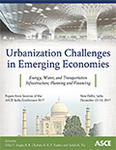ASCE India Conference 2017
Phytoremediation—A Sustainable Solution for Reducing Heavy Metal Contamination from the Bhalaswa Landfill Site
Publication: Urbanization Challenges in Emerging Economies: Energy and Water Infrastructure; Transportation Infrastructure; and Planning and Financing
ABSTRACT
The physico-chemical characteristics of the Bhalaswa Landfill site were studied by analyzing soil and plants species to estimate the heavy metals contamination of the site. The aim of this study was to explore the feasibility of using phytoremediation for reducing environmental contamination of heavy metals due to landfill site. The five most abundant plants species identified in the region were: Prosopis juliflora, Riccinus communis, Calotropis procera, Chenopodium murale, and Chrysopogon zizanioides, used as the indicators for the level of contamination at the site. The samples were collected from 0 m, 500 m, 1000 m, and 2000 m distance from the landfill site to assess the variations in heavy metals contents as a function of distance from the landfill site. Bio-concentration factor revealed the result that C. zizanioides was the best accumulator for iron, C. murale for copper and cadmium, and P. juliflora for silver and therefore can be used for the phytoremediation of the contaminated site. The lowest moisture content of 3.45% in soil was found to be at the landfill site, indicating high amount of dry density and thereby increased level of gas transport. One approach in making dumping of solids wastes on this landfill sustainable with regards to heavy metals pollution could be to grow these plants and harvest them upon maturity. This could help in controlling increased rate of heavy metal pollution of soil, groundwater in this region. A conscious effort is needed now to slow down the increase of metal pollution due to the Bhalaswa Landfill for protecting human health and environmental health.
Get full access to this article
View all available purchase options and get full access to this chapter.
ACKNOWLEDGEMENTS
The work was done by the first author in IIT DELHI, New Delhi as a part of the summer research project of TERI University, New Delhi. The authors would like to acknowledge the support of the site officials of the Bhalaswa landfill site, New Delhi and Dr. Sanjay Kumar Gupta, Environmental Engineering Laboratory, Dept. of Civil Engineering, IIT Delhi for providing the assistance during the working period.
REFERENCES
1.
Ahmad, A., Ghufran, R., Zularisam, A.W. (2011) “Phytosequestration of Metals in Selected Plants Growing on a Contaminated Okhla Industrial Areas, Okhla, New Delhi, India.” Water Air Soil Pollut, 217:255-266.
2.
Ali, H., Khan, E., Sajad, M.A. (2013)“Phytoremediation of heavy metals—Concepts and applications”. Chemosphere 91.869-881.
3.
Bauddh, K., Singh, R.P. (2012) “Cadmium Tolerance and Its Phytoremediation by Two Oil Yielding Plants Ricinus Communis (L.) and Brassica Juncea (L.) From The Contaminated Soil.” International Journal of Phytoremediation, 14:8, 772-785.
4.
Chabukdhara, M., Nema, A. (2012) “Heavy Metals in Water, Sediments, and Aquatic Macrophytes: River Hindon, India.” J. Hazard. Toxic Radioact. Waste, 2012, 16(3): 273-281.
5.
Ding, Y.Z., Z. G. Song, R. W. Feng, J. K. Guo (2014) “Interaction of organic acids and pH on multi-heavy metal extraction from alkaline and acid mine soils.” International Journal of Environmental Science and Technology February 2014, Volume 11, Issue 1, pp 33-42.
6.
Fitz, W.J. and Wenzel, W.W. (2002) “Arsenic Transformations in the Soil-Rhizosphere-Plant System: Fundamentals and Potential Application to Phytoremediation.” Journal of Biotechnology, 99, 259-278.
7.
Jones, D.L., Williamson, K.L., Owen, A.G. (2006) “Phytoremediation of landfill leachate.” Waste Management 26, 825-837.
8.
Khan, A.G., Chaudhry, T.M., Khoo, C.S., W.J. Hayes, (2000) “Role of plants, mycorrhizae and phytochelators in heavy metal contaminated land remediation.” Chemosphere 41, 197-207.
9.
Mohammed, N. Al-Yemni, Sher, H., Ebrahem, M. Eid. (2011). “Bioaccumulation of nutrient and heavy metals by Calotropis procera and Citrullus colocynthis and their potential use as contamination indicators.” Scientific Research and Essays Vol. 6(4), pp. 966-976, 18.
10.
Mubeen, H., Naeem, I., Taskeen, A. (2010) “Phytoremediation of Cu(II) by Calotropis procera roots.” New York Science Journal. Vol. 3(3).
11.
Prasad, M.N.V (2003) “Phytoremediation of Metal-Polluted Ecosystems: Hype for Commercialization.” Russian journal of plant physiology. vol 50:686-700.
12.
Senthilkumar, P., Prince, W., Sivakumar, S., Subbhuraam, C. (2005). “Prosopis juliflora—A green solution to decontaminate heavy metal (Cu and Cd) contaminated soils.” Chemosphere 60, 1493-1496.
13.
Ratte H (1999) “Bioaccumulation and toxicity of silver compounds: A review.” Environmental Toxicology and Chemistry, 18 (1):89-108.
14.
Remon, E., J.-L. Bouchardon, B. Cornier, B. Guy, J.-C. Leclerc, O. Faure (2005) “Soil characteristics, heavy metal availability and vegetation recovery at a former metallurgical landfill: Implications in risk assessment and site restoration.” Environmental Pollution 137, 316-323.
15.
Tawde, S., Bhalerao, S. (2015) “Phytoremediation by Vetiveria zizanioides (L.) Nash from Solid Waste at Kalyan Dumpsite in Maharashtra State, India.” IJISET - International Journal of Innovative Science, Engineering & Technology, Vol. 2 Issue 4.
16.
Yoon, J., Cao, X., Zhou, Q., Ma, L.Q. (2006) “Accumulation of Pb, Cu, and Zn in native plants growing on a contaminated Florida site.” Sci. Total Environ. 368, 456-464.
Information & Authors
Information
Published In
Urbanization Challenges in Emerging Economies: Energy and Water Infrastructure; Transportation Infrastructure; and Planning and Financing
Pages: 247 - 255
Editors: Udai P. Singh, B. R. Chahar, Indian Institute of Technology, H. R. P. Yadav, Institution of Engineers (India), and Satish K. Vij
ISBN (Online): 978-0-7844-8202-5
Copyright
© 2018 American Society of Civil Engineers.
History
Published online: Dec 13, 2018
Authors
Metrics & Citations
Metrics
Citations
Download citation
If you have the appropriate software installed, you can download article citation data to the citation manager of your choice. Simply select your manager software from the list below and click Download.
